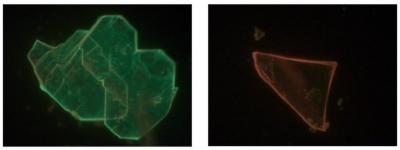Some light-emitting diodes (LEDs) created from perovskites emit light over a broad wavelength range. Scientists from the University of Groningen have now shown that in some cases, the explanation of this phenomenon is incorrect. Their new explanation should help scientists to design perovskite LEDs capable of broad-range light emission.
 Wide-field photoluminescence micrographs (230_175 μm) show how somePerovskite flakes appear bright green over their entire area (left panel), whilst other flakesexhibit a distinctly red-shifted emission (right panel). Credit: University of Groningen
Wide-field photoluminescence micrographs (230_175 μm) show how somePerovskite flakes appear bright green over their entire area (left panel), whilst other flakesexhibit a distinctly red-shifted emission (right panel). Credit: University of Groningen
Low-dimensional (2D or 1D) perovskites emit light in a narrow spectral range and are therefore used to make light-emitting diodes of superior color purity. However, in some cases, researchers have noted a broad emission spectrum at energy levels below the narrow spectrum. This has attracted great interest as it could be used to produce white light LEDs more easily compared to current processes. To design perovskites for specific purposes, however, it is necessary to understand why some perovskites produce broad-spectrum emissions while others emit a narrow spectrum.
"There are many reports in the literature where, in addition to the narrow emission of these low dimensional systems, there is a broad low-energy spectrum. And this is thought to be an intrinsic property of the material," says Maria Loi, Professor of Photophysics and Optoelectronics at the University of Groningen. Previously, researchers believed that the vibrations of the octahedron's atoms can 'trap' an excited stated in a self-trapped exciton, or self-trapped excited state, causing the broad-spectrum photoluminescence, especially in these two-dimensional systems and in systems where the octahedrons are isolated from each other (zero-dimensional).
However, observations made in Loi's laboratory appear to contradict this theory, says Simon Kahmann, a postdoctoral researcher in her team. "One of our students studied single crystals of a lead-iodide-based 2D perovskite and noticed that some crystals emitted green light and others emitted red light. This is not what you would expect if the broad red emission were an intrinsic property of this material."
The research team proposed that defects in these perovskites could change the color of emitted light. Therefore, they decided to test the mainstream interpretation with an ad hoc experiment. Loi says, "In the accepted theoretical explanation, the excitations should be larger than the bandgap to produce broad emission." The bandgap is the energy difference between the top of the valence band and the bottom of the conduction band.
Using laser light of different colors, and therefore of different energies, they studied the emission of the crystals. "We noted that when we used photons below the bandgap energy, the broad emission still occurred," says Loi. "This should not have happened according to the mainstream interpretation."
Their explanation is that a defect state with an energy level inside the bandgap is governing the broad emission and the large color variation of the crystals. "We think that it is a chemical defect in the crystal, probably related to iodide, that causes states inside the band gap," says Kahmann. Thus, the broad emissions are not an intrinsic property of the material, but are caused by an extrinsic effect. Kahmann: "At this point, we cannot totally rule out that this is a quirk of lead iodide perovskites but it is likely to be a general property of low-dimensional perovskites." This finding has profound consequences, explains Loi. "If we want to predict new and better compounds that broadly emit light, we need to understand the origin of this emission. We should not be tricked by this chameleon."

